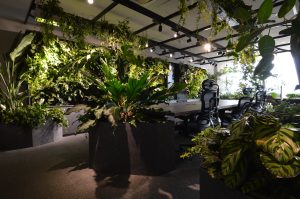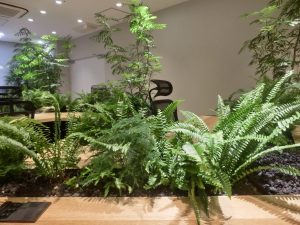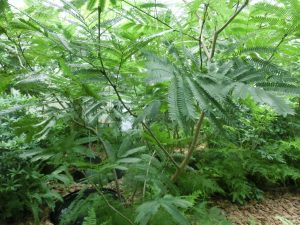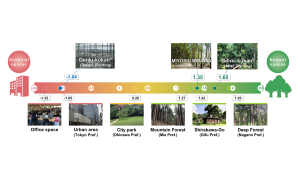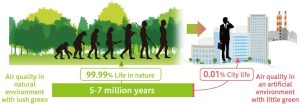Toyota’s Frontier Research Centre studies the benefits of leafy spaces and optimal air quality for human well-being
A team of Toyota’s advanced research division, the Frontier Research Centre, has been seeking to unravel the mysteries of how plants and air quality contribute to human well-being.
Therefore, the specialist team from the Frontier Research Centre as well as Toyota Central R&D Labs., Inc. (TCRDL), the research institute of the Toyota Group, has been jointly seeking to verify the effects on humans of a range of environmental factors, including plant colours and shapes, and microorganisms and chemical substances in the air.
Toyota’s researchers brought soil and planted dense vegetation to reproduce an authentic, if small, forest environment in their research laboratory at the Toyota headquarters in Aichi prefecture in Japan in a bid to discover the scientific reasons for how nature can make us feel more relaxed. Visitors to the Frontier Research Centre are welcomed by a jungle-like space filled with several kinds of plants, right next to the laboratory’s office space.
The studies seek to harness nature’s power to bring comfort and boost the feel-good factor in everyday life, as part of Toyota’s mission to enhance human well-being and produce happiness for all.
Chikara Ohto, a Grandmaster with Toyota Motor Corporation explained: “Offices or living rooms that provide the same effect as being in nature can help to energise people. With that in mind, we named the project Genki-Kûkan™ (Genki meaning “health, happiness, and energy,” and Kûkan meaning “space”) because of the potential to improve mental and physical well-being.”
The Frontier Research Centre and TCRDL worked alongside Pasona Panasonic Business Service Co., Ltd. (PBS) to create three environmental control greenhouse spaces in a joint research project1: (Room #1) a space that is expected to reduce fatigue, (Room #2) a space that is expected to improve concentration, and (Room #3) a space that is expected to increase energy2.
These greenhouse-based spaces named Genki–tron™ were used to test participants spending time ranging from a few minutes to a few hours, in each of these spaces, to verify their effects.
In addition, a test space measuring 10 metres x 12 metres x 3 metres high, was created to verify the effects of spending a few days or a few weeks in the natural environment.
As part of the research, people were shown images of different types of leaves and were asked which they found more comforting. The team found that small, round leaves help to soothe and comfort, while larger, broader leaves make people feel energised, and long, narrow leaves seem to be helpful in improving concentration.
The team analysed the leaves of 50 different plant types, and indexed them according to their curviness, size, and whether their shapes reduced fatigue, improved concentration, or increased energy. The study also revealed that leaf shapes mainly influence how people feel on seeing a plant as a whole.
It is widely known that natural greenery can be comforting, but the team’s research aims to provide scientific evidence and reveal how people instinctively seek nature’s benefits.
The Genki-Kûkan™ project also involves research into the positive effects of forest air quality on people. A single person may breathe in more than 10,000 litres of air per day. Many studies look at PM2.5 (fine particulate matter) and other harmful impacts of air quality on health, but the Toyota team took a different direction, investigating air quality’s positive effects on people.
First, the team characterised the microorganisms and chemical substances in the air in nature, and then analysed their effects on humans in order to identify the quality of air that promotes human well-being. They sampled air from 466 locations around Japan, including cities, rural areas, and forests, to investigate real-world air conditions.
Advanced information processing technologies were required to decipher the tremendous amount of data obtained during the study, and one of the outcomes of this research is Biophilic Score™, a scale for measuring air quality developed jointly with the National Institute of Genetics (Mishima, Shizuoka Prefecture) by using state-of-the-art statistical and machine learning technologies of both organisations. These technologies make it possible to estimate how close the quality of a certain air is to that in nature.3,4,5,6
Masakazu Ito, a Project Manager (on temporary assignment to TCRDL) explained the method used: “We siphoned air with an instrument like a vacuum cleaner, then extracted the DNA of microorganisms caught in a filter. We scored the ‘naturalness’ of air samples, with a value of -1 indicating a highly unnatural space. Urban areas in Tokyo scored -1.05, a city park 0.26, and deep forests in Nagano 1.93.”
Showing air quality using precise numerical values could allow for more scientific labelling of living environments and other spaces, enabling evidence-based promotion instead of conceptual communications.
Satoshi Katahira, a Group Manager (on temporary assignment from TCRDL) commented: “We are working with Toyota Housing Corporation on the MIYOSHI MIRAITO* project to develop cities that coexist with nature. In this rich natural environment, the air quality was on par with Shirakawa-go, a World Heritage Site with unspoiled Japanese landscapes. With this evidence, we can promote the residential area as a comfortable living environment offering an authentic connection to nature.”
The research team’s next step was to understand the effects of varying air quality on people.
Akinori Ikeuchi, a Project Manager (on temporary assignment from TCRDL) said: “People coexist with many species of microorganisms, including 100 trillion in the intestines and one trillion on the skin, as well as other places such as within the mouth and respiratory organs. Together, they form what is called the microbiome (MB). This symbiotic relationship evolved over a long period of time. In recent years, we’ve had less contact with nature due to rapid urbanisation, which is disrupting this symbiotic relationship. This could be a possible cause of various illnesses, including allergic diseases. We presume that taking in air rich in a variety of microorganisms plays an important role in balancing the symbiotic relationship between humans and microorganisms.”
The team applied adhesive stickers to the skin and analysed the microbiomes that adhered to them. They found significant variation in the species and quantities of skin microbiomes between individuals.
Testing the skin can also reveal whether you have been working in the office, spending a day off in the city, or enjoying the great outdoors.
According to the research findings, skin microorganisms change depending on where you spend time. Strikingly, the effect of air quality was particularly prominent when they visited the rich natural environment of a traditional village.
So how does the skin microbiome need to change in order for the skin to become genki, or healthy? In order to elucidate the mechanism, we cultivated bad bacteria (Staphylococcus aureus) and good bacteria (Staphylococcus epidermidis) on artificial skin, such as those used in skin transplants, and succeeded in creating an artificial symbiotic model of the skin and skin microbiome7, 8, 9, 10.
When the impact that air quality has on skin microbiome using this symbiotic model was evaluated, it was shown that that certain species of plants generate air quality (plant chemosignal) that creates conditions in skin microbiome symbiosis that are advantageous to good bacteria and have the effect of suppressing damage and inflammation to the skin caused by bad bacteria.
The research team presented its results to various academic societies, demonstrating the eye-opening possibility that coexisting with diverse bacteria may be better for our health than being germ-free.
These research outcomes came by questioning accepted wisdom and investigating ideas that might contribute to the well-being of others. The team’s findings have been a breath of fresh air in academic circles, so the research continues in its bid to establish evidence-based space design to improve people’s health and contribute to the happiness of all.
ENDS
Editors’ notes:
* https://www.miyoshi-miraito.jp/
1 “Joint research with Toyota Motor Corporation to study the effects on humans of spaces where people and plants coexist” (Pasona Panasonic Business Service project) (Japanese Only)
2 C. Ohto, “Research into biophilic spaces to improve well-being (Part 1): An overview of the research and creation of biophilic space laboratories” (Presentation #40037, 2020 Annual Convention, Architectural Institute of Japan) (Japanese Only)
3 Japanese Patent application: 2021-005128
4 A. Toyoda, “Study of airborne and skin microbiome Part 2 Comprehensive analysis of indoor and outdoor airborne microbiome” (Presentation #P-57D, the 15th Annual Meeting, Society of Genome Microbiology, Japan)
5 K. Higashi, “Study of airborne and skin microbiome Part 6 naturalness prediction model based on airborne microbiome” (Presentation #P-61D, the 15th Annual Meeting, Society of Genome Microbiology, Japan)
6 S. Katahira, “Study of airborne and skin microbiome Part 7 Evaluation of air quality using naturalness prediction model” (Presentation #P-62A, the 15th Annual Meeting, Society of Genome Microbiology, Japan)
7 K. Kohda, “Study of airborne and skin microbiome Part 5 Establishment of a method for evaluating the impact of skin MB” (Presentation #P-60C, the 15th Annual Meeting, Society of Genome Microbiology, Japan)
8 K. Kohda, “Analysis of symbiotic microbes effects on 3D epidermal model” (Presentation #6-10, the 72nd Annual Meeting, Japan Society for Cell Biology)
9 Naoki Soga, “An in vitro mixed Infection model with commensal and pathogenic Staphylococci for the exploration of interspecific interactions and their Impacts on skin physiology”, 2021, Cell Bio Virtual 2021
10 K. Kohda, X. Li, N. Soga, R. Nagura, T. Duerna, S. Nakajima, I. Nakagawa, M. Ito and A. Ikeuchi “An in vitro mixed infection model with commensal and pathogenic Staphylococci for the exploration of interspecific interactions and their impacts on skin physiology” 2021, Front. Cell. Infect. Microbiol., 11, 712360

